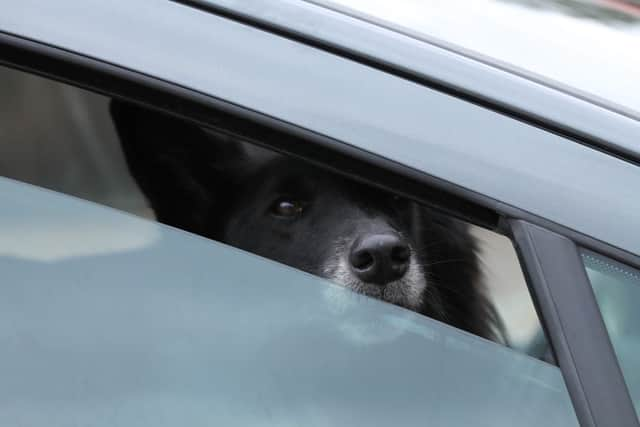Leaving a dog in a hot car - the fine owners can face and what to do if you see a dog in distress


With most of the UK set to enjoy its first real taste of summer, pet owners are once again being warned of the dangers of leaving their pets in the car.
Some parts of the country will see temperatures up to 24C degrees and animal charities, including the RSPCA and its Scottish counterpart, the SSPCA, have warned of the potentially deadly consequences of leaving a dog in a hot car, even for a short period of time.
Advertisement
Hide AdAdvertisement
Hide AdDespite repeated campaigns by animal welfare groups, many people still believe that it is acceptable to leave a pet in a car on a hot day as long as the windows are left open or it is parked in the shade.
However, even with an outside temperature of a relatively mild 22 degrees, within an hour the inside of a car can reach a dangerous 47 degrees.
Trapped in such temperatures, dogs are at risk from fatal heatstroke and even cardiac arrest.
Is it illegal to leave a dog in a hot car?
It is not illegal to leave a pet unattended in a car. However, if the animal becomes ill or dies due to being left, you can be charged with animal cruelty.
Advertisement
Hide AdAdvertisement
Hide AdIn such cases, you can be sent to jail and handed a massive fine. In the most extreme circumstance these stretch to up to 12 months in jail and a £20,000 fine.
In 2017 one pet owner was fined nearly £2,000 when his three dogs died after being left for five hours in a hot car.
What to do if you see a dog in a hot car


If you spot a dog or other animal in distress in a car on a hot day the advice is to take immediate action.
If you’re in a public area such as a shop, venue, event or roadside service area, note the car make, model, colour and registration number, then go inside and ask for an announcement to be made.
Advertisement
Hide AdAdvertisement
Hide AdIf this doesn’t bring the owner out, or you’re in a location where finding the owner is impossible, then dial 999 and ask for the police.
If you feel the situation is critical, the animal is suffering and there’s no other option, you can smash a window to rescue the dog but be aware that there are legal implications.
Breaking into the car to rescue an animal could still be viewed as criminal damage and you could have to defend your actions in court.
The RSPCA’s advice if you choose to take such action is to make sure you tell the police in advance what you intend to do and why. Take pictures or videos of the dog and the names and numbers of witnesses to the incident.
Advertisement
Hide AdAdvertisement
Hide AdThe law states that you have a lawful excuse to commit damage if you believe that the owner of the property that you damage would consent to the damage if they knew the circumstances.
If the animal isn’t in obvious distress but you are worried about it, the RSPCA has the following advice
- Establish how long the dog has been in the car. A 'pay and display' ticket could help.
- Make a note of the car's registration. If the owner returns, but you still feel the situation was dangerous for the dog, you may still report the incident to the police.
- If you're at a shop, venue or event ask the staff to make an announcement to alert the owner of the situation.
- If possible, get someone to stay with the dog to monitor its condition. If it sbegins to display signs of distress or heatstroke, be prepared to dial 999.
How to spot and treat a dog in distress
There are certain symptoms that show a dog is suffering from heatstroke, and these apply to pets travelling with you in a car, as well as those stuck in a parked vehicle.
Signs of heat exhaustion/heatstroke include excessive thirst, heavy panting, rapid pulse, fever, vomiting, glazed eyes, dizziness and lethargy.
Advertisement
Hide AdAdvertisement
Hide AdIf an animal is displaying these symptoms, the RSPCA recommends dousing the animal with cool (not cold) water or using wet towels or a fan to help cool it. You should also let it drink small amounts of cool water and take it to a vet to be checked.